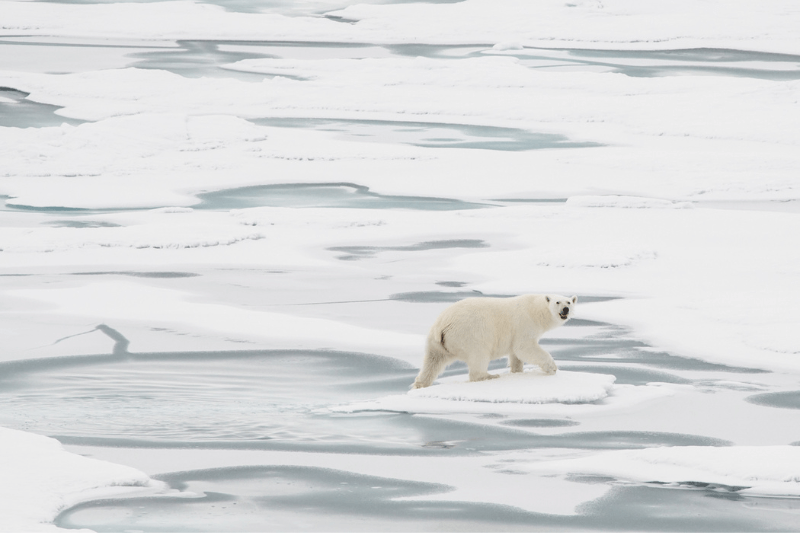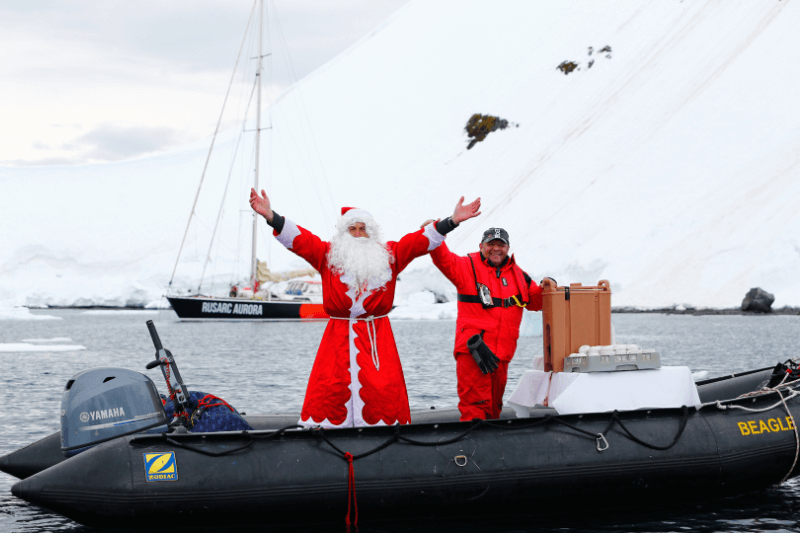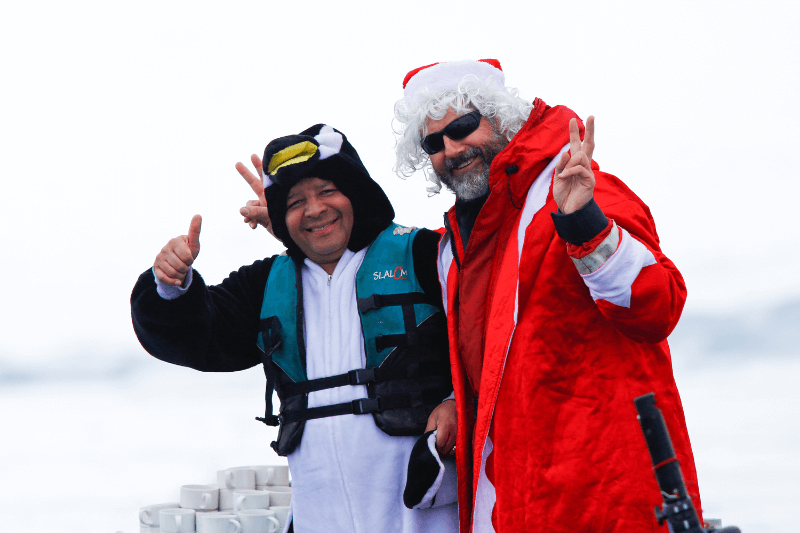Where Does Santa Live?
He sees you when you’re sleeping…and thanks to his little helpers (aka elves on the shelves) Santa Claus knows which kids were good and which ones need a little personal improvement to be eligible for Christmas gifts. As the popular legend goes, the elf on the shelf sneakily moves around the house during the day, appearing in different places, snitching on children and flying back to the North Pole each night to report on what he observed. While different cultures may have their very own explanation of how Santa knows what’s going on year-round in homes around the globe, we’re curious about his actual whereabouts: where does this generous gentleman actually live?

Does Santa live at the North Pole?
We’ve been to the North Pole multiple times on our icebreaker expedition cruises and have not seen Santa Claus yet. We can also be rather sure that Santa doesn’t reside at the South Pole, since his sleight isn’t pulled by penguins, but reindeer. At the geographical North Pole there’s not much apart from ice and ocean below (at exactly 90 Degrees North there is no land - just pack ice floating on the Arctic Ocean), so it’s not prime real estate for Santa Claus to set up a shop to manufacture millions of toys for kids around the world. So maybe the North Pole then just indicates the general direction? Let’s take a broader look at areas around the Pole and see which places in the High Arctic would make a good start for our search for Santa Claus. Scandinavia, Canada, Greenland, Russia and United States (Alaska) have territories on the Arctic Circle and in close proximity to the North Pole, so let’s begin our journey to find Santa by following local legends and traditions.

At the geographical North Pole there’s not much apart from ice and ocean below
Where’s it all coming from?
Believe it or not, Santa’s home wasn’t specified anywhere in particular until December 1866. That’s when Victorian cartoonist Thomas Nast depicted the famous character in Harper’s Weekly magazine. Santa’s sleigh had already been pictured being pulled by reindeer as early as 1820, so one could have loosely assumed that he resided somewhere in the Arctic. Most parts of the world associate Christmas with snow, ice and pine trees. So what better place could there be for the patron of these festivities than a northern country with a maximum of snow days? To give it an even more mystical hue, Santa had to set up shop on the North Pole, remote enough to keep the mystery alive (who would make it that far to report the truth?). Up until 1909, humans hadn’t reached the North Pole.
But the real historical Santa Claus dates back much earlier to Saint Nicholas of Myra, a bishop in the 4th century who lived in Byzantine Anatolia, a territory located in modern-day Turkey. Legend has it that he came from a wealthy family, but gave away his inheritance to the poor and sick. He once generously gifted sacks of gold to a poor family to provide a better future for their three daughters. He apparently stuffed the gold into their shoes and stockings, and so the nowadays-popular tradition of hanging up stockings before Christmas to receive gifts was born. In Germany and Austria, he is known as Saint Nikolaus and children put their shoes on doorsteps and windows to receive gifts inside them.
Saint Nicholas of Myra died on December 6th, 343 AD and is known for producing miracles such as calming stormy seas. He also became the protector of sailors. They used to pray to the bishop when expecting rough seas and spread stories of his generous spirit throughout the world through their journeys. Catholics around the 13th century rekindled his memory by starting to celebrate the anniversary of his death and to this day children in Germany and Austria receive gifts in his honor by Saint Nikolaus on December 6th. Nowadays the Santa Claus we know and love so dearly is only loosely based on the legendary character of Saint Nicholas of Myra, but the gift giving aspect of this story transcended through the centuries, regaling children (and merchants) around the world every year over and over again.
Parallels to Santa Claus in Norse culture
Germanic people believed that the Norse god Odin kept two ravens that would spy and listen on people’s chimneys to find out and report who was good and bad. Sounds a bit like the elf on the shelf, right? During the Yule holiday celebration (December – January) Odin, described as wearing a long beard, would ride down from the sky on his eight-legged horse Sleipnir. According to the legends, children would leave their boots out filled with hay for Sleipnir and Odin would bring treats for them in return.
Where else do people think Santa Lives?
If Santa doesn’t reside at the geographical North Pole, where else could he have set up shop? Ask different cultures and you’ll get very different opinions about his whereabouts. People who live in the Arctic all seem to have their own magical cold, snowy and remote place where they picture Santa Claus. Read on and embark with us on an expedition through various Arctic countries in the search of this elusive bearded cultural figure.

1. Santa lives in Lapland, Finland
Sparsely populated, the 100,366 square kilometers (38,751 square miles) of taiga forest, swamps and lakes make for the perfectly remote and quaint home of Santa. Winters in Lapland are quite chilly with an average temperature of -16 °C (3 °F) to 3 °C (37 °F) and you can expect around 200 days of snow each year. Nothing brings you more into the Christmas mood than snow-covered pine trees! There are also plenty of reindeer roaming the coniferous forests and feeding on moss, grass, twigs and bushes. But where in this large territory (which covers roughly a third of Finland) can we find Santa Claus? It turns out that Finnish Santa has an address (or several) in Rovaniemi, a small town just about 8 km (5 miles) above the Arctic Circle. Joulupukki, the Finnish version of Santa Claus, loves visitors from around the world. He avoids hiding in a remote and hidden forested part of the country, so there are lots of places you can meet him and his helpers in person. Visit Santa Claus Village any day of the year for various Santa-related activities such as reindeer meet and greet, snow mobile riding, a petting zoo at the elf’s farmyard, snow castles and an igloo hotel. If you’re lucky, you’ll even get to see the northern lights. And of course, for a small token of appreciation (starting at around 30 Euros), you can have your picture taken with Mr. Claus.
2. Santa Claus lives in Greenland
According to locals, Juulimaaq (as Santa Claus is called) lives at a place called Uummannaq in central-western Greenland. Once you see this quaint fishing village with only 1,407 inhabitants, you’ll understand why old Santa chose this place for a small summer residence. Located above the Arctic Circle on a small island off the coast of Greenland, it features a tundra climate with cold, short summers and long and snowy winters, with temperatures dropping to -20 °C (-3 °F). Greenland Santa appreciates peace and quiet and owns a little hut that’s about a one hour hike out of town. It’s a small traditional rock and turf hut at the base of mount Uummannaq overlooking Qasigissat Bay. You can follow the red dot markings from the town center to find his little house. And should you spot Santa spending his summer holidays after a busy Christmas season, give him a little peace and rest! After all, who likes to be disturbed during a well-deserved summer vacation?
3. Santa Claus lives in North Pole, Alaska
Don’t get confused! The city of North Pole in interior Alaska is nowhere near the geographical North Pole and a decent distance of 200km (125 miles) below the Arctic Circle. Still, Santa’s spirit lives here year round. Since 1952, Santa Claus regales visitors with a remarkable selection of collectibles, apparel, sweets, Christmas ornaments and decorations. A 15m (50 feet) Santa statue and sleight outside the building ensure you won’t miss this little treasure chest of year-round Christmas fun. You’ll see it on your right, driving south from the city of Fairbanks, just off the Richardson Highway.
4. Santa Claus lives in Russia
Russian Santa Claus (called Ded Moroz, which can be translated as Father Frost) lives in Veliky Ustyug, a charming town in the Russian northwest with a population of about 31,000. Since 1999 his residence was officially registered in this town from which he travels across the country on January 7th (and, for some families, already on New Year’s Eve) to bring gifts. Father Frost does not need little elves, but has a charming maiden (called Snegurocka, which can be translated roughly as Snow Maiden) who helps distribute gifts to the good kids of Russia. Want to meet him in person? Father Frost actually has five residences across Russia and you can track him down to any of these: Veliky Ustyug, Kuzminki (Moscow region), Toksovo (Leningrad region), Chalna (Republic of Karelia) and Sharkan (Republic of Udmurtia). And in case you ever make the arduous journey to the coldest inhabited village in the world, Oymyakon in Yakutia, Father Frost may await you to congratulate your bravery with a small ceremony and a certificate of completion.
5. Santa Claus lives in Spain
Yes, we’re not kidding you. The Dutch consider Sinterklaas’ residence (their version of Santa Claus) to be in Spain. Every year he sails from Spain to the Netherlands and arrives mid-November on a ship in Amsterdam, just in time for the holiday season and bringing gifts for the children. Gifts are traditionally given on December 5th and 6th (depending on the region) and Sinterklaas even gets his own parade through Amsterdam!
So where is Santa’s real residence?

Ask yourself why you need to find the real place where Santa Claus lives. The legend of Santa Claus is a beautiful interpretation of a generous gesture by a historic figure, reinvented, perfected and influenced by local cultures. Each country and culture found a beautiful way to celebrate Christmas and to imagine the traditional character associated with this event in its very own way.
And it’s not only Santa Claus who enriches the holiday festivities! In Catholic parts of Austria, south and western Germany an angelic child-like figure brings presents on the eve of December 24th. In addition to the old white-bearded Santa Claus, Scandinavian folklore believes Christmas gnomes to be mostly in charge of distributing the presents. And Santa isn’t always wearing his traditionally red signature outfit. When Santa comes to Hawaii, Kanakaloka (as he is called there) changes into a colorful Hawaiian shirt.